Janis, Jimi and Jim…a Strange Kozmic Experience
April 29, 2010
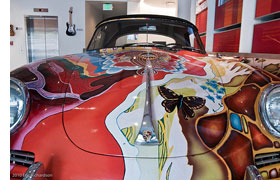 Somebody once said (we forget who) that if you remember the ‘60s, you weren’t there. So why not trip on over to The Grammy Museum in downtown’s L.A. Live entertainment complex and revisit that Strange Kozmic Experience through the Museum’s third major special exhibit, dedicated to artifacts, posters, photos and writings from three of the most influential artists of the era: Janis Joplin, Jimi Hendrix and Jim Morrison of the Doors. All three died at the age of 27—Joplin and Hendrix of drug-related causes within a month of each other in the fall of 1970, and Morrison the following July of a heart attack after years of heavy drinking. But as a recent documentary on Morrison and the Doors noted, you can’t burn out if you were never on fire—and for many, the 1960s still represent a decade of unmatched social ferment, social experimentation, artistic creativity and political activism. Check out the scene and catch a glimpse of what it was all about—or better yet, gather your friends and call the Grammy Museum’s Group Sales Department at (213) 765-6800 (ext. 3) or submit your group tour request online. Regular Museum hours are Sunday – Friday 11:30 a.m.- 7:30 p.m., and Saturday 10:00 a.m. – 7:30 p.m.. It’s located on the corner of Olympic and Figueroa St. on the L.A. Live campus.
Somebody once said (we forget who) that if you remember the ‘60s, you weren’t there. So why not trip on over to The Grammy Museum in downtown’s L.A. Live entertainment complex and revisit that Strange Kozmic Experience through the Museum’s third major special exhibit, dedicated to artifacts, posters, photos and writings from three of the most influential artists of the era: Janis Joplin, Jimi Hendrix and Jim Morrison of the Doors. All three died at the age of 27—Joplin and Hendrix of drug-related causes within a month of each other in the fall of 1970, and Morrison the following July of a heart attack after years of heavy drinking. But as a recent documentary on Morrison and the Doors noted, you can’t burn out if you were never on fire—and for many, the 1960s still represent a decade of unmatched social ferment, social experimentation, artistic creativity and political activism. Check out the scene and catch a glimpse of what it was all about—or better yet, gather your friends and call the Grammy Museum’s Group Sales Department at (213) 765-6800 (ext. 3) or submit your group tour request online. Regular Museum hours are Sunday – Friday 11:30 a.m.- 7:30 p.m., and Saturday 10:00 a.m. – 7:30 p.m.. It’s located on the corner of Olympic and Figueroa St. on the L.A. Live campus.
Race/LA and CityRace Urban Adventure Hunts
April 29, 2010
Some people love nothing better than a beautiful bike ride through the sunny Southern California landscape, or a vigorous walk through Southland neighborhoods and along roads less traveled. For others, nothing appeals more than the cerebral pursuit of hunting down clues and connecting the dots to solve a cracking good mystery. Race/LA and CityRace Urban Adventure Hunts offer thrill-seekers a chance to do both—hop on a bike or set out on foot in small teams of 2-4 participants to explore various locales and gather the clues and information needed to solve the mystery and be the first to cross the finish line.
CityRace “The Ride” takes place on Saturday, May 1, starting at 10:30 a.m. on the Santa Monica bike path. Details and registration information are here.
Race/LA, now in its 6th year, was inspired by the popular Amazing Race TV show, and takes place on consecutive weekends, May 15 and May 22 (this one’s already sold out, however.) CityRace events take place on foot through various areas such as Old Town Pasadena, Santa Monica and the Pacific Palisades. You can also join an LA Metro Art expedition to visit the striking public art installations on the region’s Red and Purple Line subway stations.
Here’s more information about the events. Here’s where you register to participate. Need a bike? No problem—check out out this list of bike rentals. Interested in keeping tabs on future events? Sign up for their newsletter.
More fixes ordered for child-welfare database
April 29, 2010
 Pushing to improve a key tool in child welfare investigations, the Board of Supervisors unanimously approved a motion Tuesday to increase the use and utility of a multi-departmental database for child social workers.
Pushing to improve a key tool in child welfare investigations, the Board of Supervisors unanimously approved a motion Tuesday to increase the use and utility of a multi-departmental database for child social workers.
The motion, authored by Supervisor Mark Ridley-Thomas, instructs the county CEO and other departments to make and track improvements to the Family and Children’s Index system over the next year.
The FCI system is a computer database that provides child welfare social workers with key medical, law enforcement and social services information, The system came under review last year after a series of high-profile deaths of children in county care prompted a new examination of potential holes in the child-welfare safety net.
County officials discovered that the FCI system was badly underutilized by county agencies, including the Department of Children and Family Services, its primary beneficiary. Supervisors agreed on ordering improvements, but opinion divided over whether the ultimate goal was to repair the FCI system or to scrap it for another computer-based system.
This week’s vote was an endorsement for reform rather than replacement.
“We are going to move full speed ahead” with reforming FCI, Supervisor Zev Yaroslavsky said at the conclusion of the discussion.
The motion also gives the CEO’s office 60 days to suggest ways to augment FCI using “best practices” from alternative systems in use elsewhere, provided they are legal in Los Angeles.
“This moves us forward in a way that doesn’t discard FCI, but augments it with the benefit of looking at other systems,” Ridley-Thomas told colleagues during the board meeting.
FCI is designed to be especially useful in the early stages of investigating child-welfare allegations, as emergency social workers prepare for a first visit to an at-risk child’s home.
Social workers need a quick, comprehensive way to understand the history of the family’s interactions with county agencies.
In the past, departments often failed to log relevant information, and some DCFS social workers did not check the database before launching investigations. Some departments hadn’t even completed memoranda of understanding about rules that would govern their work with FCI.
Last year, supervisors ordered county departments to begin aggressively implementing the system, including uploading more complete data and retraining staffers in its use. Training was completed in January, and FCI use has risen significantly. The number of “queries” rose from about 13,700 per month last summer to over 23,000 in March, according to FCI figures.
Still, problems remain that can’t be solved with technological fixes. The county is trying to resolve concerns over sharing certain information by working toward changes in state law and ways to keep in compliance with federal health-care privacy concerns.
“We need to have complete real-time information when we knock on that door,” Mike Ross, a supervising children’s social worker at DCFS in El Monte, told the board during Tuesday’s meeting.
Posted 4-29-10
Embracing the Hollywood homeless
April 29, 2010
“I’m Kerry, what’s your name?”
It’s 4:30 a.m. on Monday, and Kerry Morrison, a Hancock Park mother of two teens, stops a limping man named Vicente at a Chevron station on Highland Avenue in Hollywood. The tall woman with the clipboard is calm, friendly and matter of fact.
“I want to ask you some questions about being homeless.”
With a bit of sweet talk—and a free meal card from Subway—Morrison cajoles Vicente to share his saga of street life, which includes frostbite, substance abuse and jail time.
“I’m so happy that this is finally happening,” Morrison says walking down Hollywood Boulevard after speaking to Vicente. “We need to do everything we can to humanize the homeless.”
Morrison is one of more than 50 volunteers collecting data for the Hollywood Homeless Registry, a three-night survey that marks the first detailed study of the full homeless population in that area.
She’s also the driving force behind the whole effort.
Morrison, 54, is executive director of the Hollywood Entertainment Business Improvement District, a band of 250 business owners working to improve economic and quality of life conditions on Hollywood Boulevard. She’s worked for more than two years to bring together non-profits, government and business groups in a coalition called Hollywood 4WRD to help end the neighborhood’s longstanding homeless problem.
“Kerry’s been the hub,” says Fabio Conti, owner of Fabiolus Café on Sunset Boulevard who brought jackets and blankets to hand out to the homeless. “She’s the happiest lady in the world when she’s talking to these people.”
Beth Sandor, field director in Los Angeles for Common Ground, a homeless advocacy group that developed the four-page “vulnerability index” questionnaire used in the survey, praised Morrison as “one of the most committed business leaders in Los Angeles on the issue of ending homelessness.”
The purpose of Common Ground’s 38-question survey is to identify those most likely to die on the streets and provide them with housing and comprehensive medical, mental health and social services. The questions focus on factors such as the number of recent emergency-room visits, jail stints, substance abuse problems and chronic illnesses.
The vulnerability index was instrumental in the creation of Project 50, the groundbreaking program launched more than two years ago at the urging of Supervisor Zev Yaroslavsky that has housed and provided services for 66 once-chronically homeless individuals on L.A.’s Skid Row. That program has now been replicated in other parts of Yaroslavsky’s district, including Venice, Santa Monica and Van Nuys.
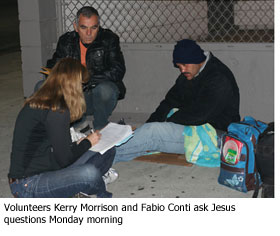 Before the pre-dawn launch of the Hollywood effort, the supervisor spoke to the survey volunteers and then headed onto the streets with them. By Wednesday afternoon, questionnaires had been completed for 257 homeless men. Another 70 declined to participate. More than 82 percent of the Hollywood homeless were men, whose ages ranged from late teens to a newly-homeless man of 80.
Before the pre-dawn launch of the Hollywood effort, the supervisor spoke to the survey volunteers and then headed onto the streets with them. By Wednesday afternoon, questionnaires had been completed for 257 homeless men. Another 70 declined to participate. More than 82 percent of the Hollywood homeless were men, whose ages ranged from late teens to a newly-homeless man of 80.
Morrison once seemed like an unlikely champion for Hollywood’s homeless. Raised in a middle-class Denver suburb, the daughter of a steel salesman, Morrison worked in government affairs at the California Association of Realtors for over a decade after moving to L.A. in the late 1970s.
Jolted by the 1992 riots to aid in the city’s recovery, she became executive director of the new Hollywood business improvement district, and came face to face with the neighborhood’s homeless problem.
As Hollywood worked to gentrify, some business owners—and many residents—hoped the solution to the homeless problem was simply to move the street people out. Morrison disagreed and vowed to educate herself and her board members.
She came to prefer the “permanent supportive housing” model, in which individuals are given apartments along with a variety of services to help them lead more stable and healthy lives. Her view was far from prevalent. When a 60-unit project was proposed for Gower Avenue in 2006, the backlash stunned Morrison.
“The community vitriol was mind-boggling,” she recalls. To this day, the project remains on hold.
In 2008, Morrison invited then-President Bush’s homeless czar, Philip Mangano, to make the case for permanent supportive housing as a better solution than shelters for the urban homeless. Later, she organized a field trip to visit Step Up on Second’s permanent supportive housing facility in Santa Monica. She put together a “snapshot” count of Hollywood’s homeless that year that found about 500 people living on the streets.
As part of her education, Morrison also realized she needed to get closer to her homeless neighbors. “I made a commitment to start talking to homeless people,” she recalls. “I had to conquer my own fears.”
She befriended local street people, including a mentally-ill man named Torrey who slept along the Walk of Fame until Morrison pushed for his hospitalization. He now lives in a Hollywood motel, although he declines to take his medication, Morrison says.
The experience taught her that it was essential for business owners and the public to see the homeless as people with individual stories.
That’s why the Hollywood team will take the unusual step of announcing the names and profiles of the 10 most vulnerable among Hollywood’s homeless at a news conference at 2 p.m. Friday at the Los Angeles Film School, 6353 Sunset Boulevard.
“We know that getting housing for them won’t happen unless we put the names and faces to the issue,” Morrison says.
The problem, Morrison notes, is that there aren’t yet apartments and housing in place for these individuals. Step Up on Second has bought a motel on Vine Street for permanent supportive homeless housing, but construction has yet to get underway. A committee is working to identify other housing possibilities, Morrison says.
She hopes publicity from the survey will lead to housing breakthroughs. She notes happily that Los Angeles City Councilman Tom LaBonge and two staffers joined the survey Tuesday morning and hopes he and other city leaders will come through with help on the housing front.
“The survey is an essential step,” says Morrison. “I’m incredibly optimistic that Hollywood can be a community that can embrace the homeless.”
Posted 4-29-10
Read related story
On his blog, Zev writes about his night with the Hollywood homeless.
Avoiding a brush with fire disaster
April 29, 2010
The big rains of winter mean a big explosion of vegetation come spring—which can mean big trouble when the inevitable wildfires hit Southern California. So homeowners in “wildland areas” can expect a visit soon from the Los Angeles County Fire Department, which is beginning brush clearance inspections of more than 39,000 homes on Saturday. (Inspections in coastal areas start June 1.) To stay on the safe side, check out the county’s brush clearance guidelines, download your own “personal wildfire action plan” prepared by the fire department as part of its Ready! Set! Go! program, and check out these videos. And then click on “A Road Map to Fire Safety: How to Create Defensible Space in the Santa Monica Mountains,” a new guide from the Fire Safe Alliance.
Posted 4/29/10
A longer run for “Emmett Till”
April 29, 2010
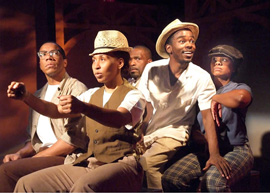 Hollywood’s Fountain Theatre kicked off its 20th Anniversary Season in February with the West Coast premiere of playwright Ifa Bayeza’s “The Ballad of Emmett Till.” Now the theater has just extended the play’s run from April 29 through May 30.
Hollywood’s Fountain Theatre kicked off its 20th Anniversary Season in February with the West Coast premiere of playwright Ifa Bayeza’s “The Ballad of Emmett Till.” Now the theater has just extended the play’s run from April 29 through May 30.
Till was a 14-year-old Chicago youth murdered in 1955 while visiting family in the Mississippi Delta. His brutal killing became a seminal event in the early days of the civil rights movement. The killers, a pair of white men, were acquitted by an all-white jury but later admitted to the crime in a paid Look magazine interview.
Bayeza’s “Ballad” transforms the infamous Till tragedy into a rich gumbo of history, mystery, and jazz/folk/gospel fusion of poetry, song and essay.
Tickets range from $25-$28, with a break for seniors and students. The Fountain Theatre is located at 5060 Fountain Avenue (at Normandie) in Los Angeles. Call (323) 663-1525 for further information.
Posted 4-29-10
A walk on the wild side, Zuma-style
April 29, 2010
 The California Wildlife Center rescues native critters in distress, from bobcats to sea lions. If you’d like to help them help sick, injured or orphaned animals, head out to Zuma Beach on Sunday for the organization’s 2nd annual “Walk on the Wild Side” fundraiser. There’s a 5K beach walk, and they’re also promising a “wild DJ,” celebrities, snacks and “a real wildlife release right on the beach.”
The California Wildlife Center rescues native critters in distress, from bobcats to sea lions. If you’d like to help them help sick, injured or orphaned animals, head out to Zuma Beach on Sunday for the organization’s 2nd annual “Walk on the Wild Side” fundraiser. There’s a 5K beach walk, and they’re also promising a “wild DJ,” celebrities, snacks and “a real wildlife release right on the beach.”
Posted 4/29/10
Uncle Sam heads to The ’Bu
April 29, 2010
Malibu, expect a knock on your door.
Beginning on Saturday, May 1, thousands of U.S. census takers will take to the nation’s streets, canvassing households that did not mail back their 2010 Census forms.
And nowhere in Los Angeles County was that return-rate worse than in the City of Malibu. As of this week, the Census Bureau had received forms from just 58% of addresses in the famed beach town, compared to a countywide average of 70%.
Malibu Mayor Jefferson “Zuma Jay” Wagner said he’s embarrassed by his city’s dubious civic distinction. For a year, he says, he’s been preaching: “When in doubt, fill it out.”
“I guess I need a bigger PR firm. Actually, I don’t have a PR firm,” Wagner joked.
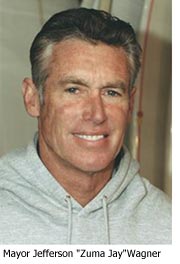 Malibu, he explained, has a sizable number of vacation homes. Owners are not required to send back the 10-question forms. But Wagner thinks that’s only part of the explanation for the city’s poor showing.
Malibu, he explained, has a sizable number of vacation homes. Owners are not required to send back the 10-question forms. But Wagner thinks that’s only part of the explanation for the city’s poor showing.
Doing his best not to offend, the mayor said he suspects that some of Malibu’s wealthier residents probably didn’t see the form because they don’t open their own mail, while others simply tuned out the Census Bureau’s pitch that participation is crucial in determining how $400 billion in federal dollars is spent in communities across America.
“I call it: IGM—I Got Mine,” Wagner said.
The mayor noted that, despite Malibu’s glitzy reputation, a sizable portion of the city’s population of 15,000 is comprised of “working folks” who do take seriously the importance of the Constitutionally-mandated census, which occurs every 10 years. Unfortunately, Wagner said, the Census scofflaws have not put “a good face” on the city’s image.
The next phase of the count—personal visits from census workers—is expected to lift the town’s participation rate, but not by much. Ten years ago, when all was said and done, only 63% of Malibu households were accounted for in the census.
Malibu, of course, is no ordinary neighborhood. Many of the multimillion-dollar homes have elaborate security systems and are difficult to access, whether they’re located along the beach or in the canyons above the ocean. “Who knows what you have to do to get to these homes?” Wagner said. “It’s going to be tough.”
That said, Wagner insisted that city leaders are determined to encourage broad cooperation with the census takers who’ll be at the doors and gates of residents. Already, an announcement has been placed on the city’s website and ads will be purchased in local papers.
The message, Wagner said, is simple: “Get on board.”
To see how your community’s participation rates stack up, check out the U.S. Census Bureau’s interactive map.
Posted 4-29-10
Trying to avert “an American tragedy” [updated]
April 29, 2010
When it comes to success stories involving tiny babies, this one is huge.
But after years of waging life-and-death battles on behalf of African American mothers and newborns, Los Angeles’ Black Infant Health program is once again fighting for its own survival.
When state funding for the program was eliminated last year, the Board of Supervisors turned to First 5 LA –the child advocacy organization charged with using tobacco tax revenues to better the lives of local children—to keep services going.
First 5, responding to this motion and amendment, came through with $1.16 million. But that funding expires at the end of June.
So now the supervisors are once again asking for help. The board on Tuesday approved a motion by supervisors Mark Ridley-Thomas and Zev Yaroslavsky asking the First 5 Commission to provide the money to keep the program going for another year. Without it, the only source of funds would be about $500,000 in federal Title V funds—enough to allow just one, or at most two, of the current five providers in the county to continue serving clients.
Infant mortality remains disturbingly high among African Americans, with black infants in California more than twice as likely as whites to die in their first year. The program, established by the state in 1989, has proven effective at lowering the incidence of deaths in the first year of life and at raising birth weights to healthier levels.
“The program works,” says Cindy Harding, director of Maternal, Child, and Adolescent Health Programs for the county Department of Public Health, noting improvements in birth weights and decreases in preterm births among program participants in L.A. County.
The First 5 Commission, chaired by Supervisor Gloria Molina, who abstained from Tuesday’s vote, also includes members appointed by each supervisorial office and representatives from the county’s departments of mental health, public health and education. The funding for the Black Infant Health program is expected to come before it on May 13.
The program’s “street-based outreach” approach aims to find women in the first trimester of pregnancy and make sure they get to all their prenatal medical appointments. It also offers “social support and empowerment” for groups of new and expectant mothers—providing help with everything from job placement to breast-feeding.
“We are the gate-opener,” says Yodit Abraha, Black Infant Health program manager for the Mission City Community Network, Inc. in Mission Hills, one of the five providers in L.A. County. “We do everything, anything, for the mommy to cater to her to provide that safety net for the baby…We’re saving future generations.”
Abraha says the program aims to be “very African American-specific and culturally sensitive,” reaching out to pregnant women who may be single and alone. She calls the infant mortality rates “an American tragedy” and says she cannot understand why a successful program should be in peril due to lack of funding.
“This is a program that is not a luxurious activity. We’re talking about life and death,” Abraha says. “No baby in America should die.”
To watch a KABC-Channel 7 report on the Mission City program last summer, click here.
Posted 4/29/10
Updated 5/14/10:
The First 5 Commission, after hearing presentations from Supervisors Yaroslavsky and Ridley-Thomas, voted to provide $1.2 million to keep the infant program funded for another year.





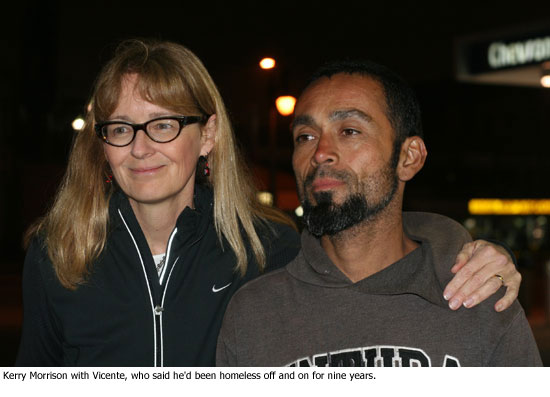
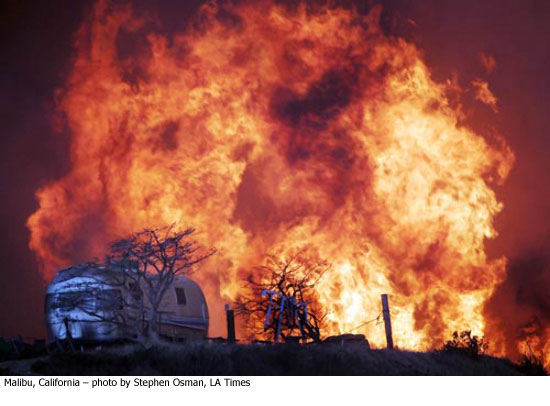
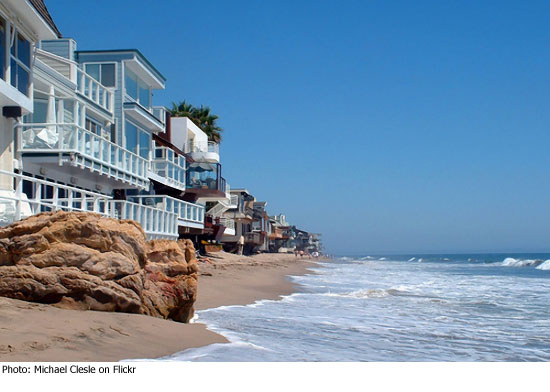
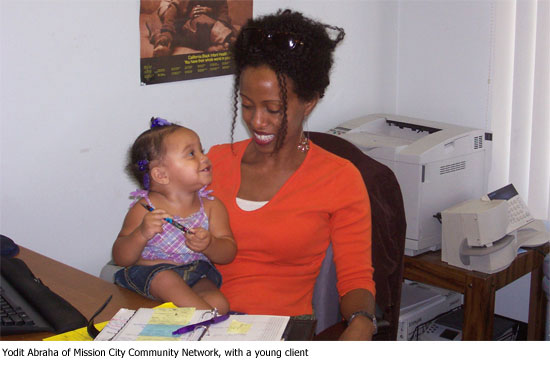





 Check for the latest closure information
Check for the latest closure information








